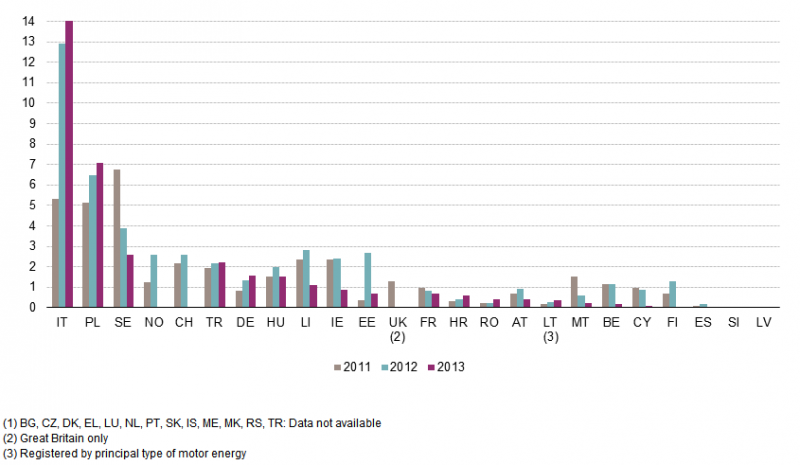While visiting Europe this summer I notice that there are numerous vehicles on the road that are propelled by alternative fuels. Other than the familiar hybrid-electric and electric vehicles, Europeans are also taking increasingly to compressed natural gas (CNG) and liquefied petroleum gas (LPG). The latter may be better known as "autogas" or simply propane. These types of vehicles have a minuscule share of the market in North America and are sometimes found in taxis, whose drivers are particularly concerned about fuel efficiency. However, as the chart below shows, some European countries have seen a rather large uptake of CNG and LPG. Italy is standing out as the country where about one in every seven new cars uses alternative fuels—and this is mostly CNG or LPG. What is driving this trend?
New Passenger Cars with Alternative Fuel Engine
% of new passenger cars, 2011-2013, European Union Countries

The rate at which Italian motorists are embracing CNG and LPG vehicles is remarkable. A closer look at new vehicle statistics reveals that this trend is driven mostly by purchases in the sub-compact market. CNG and LPG lower fuel costs substantially, while the risk of making a "wrong" decision is mitigated by the relatively low purchase cost of new vehicles in this class. The fuel economy of LPG and CNG vehicles is impressive when compared to conventional gasoline and diesel engines. In the last few years, CNG has also started to dominate the picture.
The benefits of CNG are particularly attractive in Italy where there is a large wedge between the retail price of gasoline and the retail price for CNG, combined with an extensive distribution network. Adjusted for the slightly higher purchase cost, annual mileage, and energy equivalency, CNG and LPG vehicles save about 60% compared to gasoline vehicles. (1 kg of CNG is about equal to 1.5 L of petrol.) Taxes play a role as well: they are lower on CNG than on gasoline. Italy has one of the highest taxes on gasoline. Italian motorists respond to strong price signals and economize on their fuel costs.
There are also environmental benefits to using CNG. On a per-kilometre basis, CNG vehicles emit about 6-11% less carbon dioxide over the entire life-cycle than gasoline vehicles, according to information provided by the Alternative Fuels Data Center of the U.S. Department of Energy. Natural gas also burns cleaner than gasoline, and this compares favourably in terms of nitrous oxides (NOx) emissions. Especially when CNG replaces diesel fuel in urban settings, the environmental benefits can be substantial, and the gain in urban air quality may be the most noticeable benefit in the short term. To the extent that natural gas can be obtained from renewable sources ("biomethane") rather than from fossil sources, the environmental balance improves further.
The benefits of CNG have been convincing motorists in other countries as well. China, India, Argentina, and Brazil have some of the largest CNG fleets. The prospect for CNG in North America looks mixed, however. The cost differential is much smaller than in Europe because of low taxes on gasoline and diesel. The distribution network is also much less dense except in a few urban areas. And the number of vehicle models with factory-equipped CNG remains small. Perhaps the largest benefit accrues to large fleets of vehicles: buses and trucks. High mileage combined with centralized refueling stations make CNG increasingly attractive, in particular as world oil prices recover from their current lows.
Further Readings:
- Natural Resources Canada: Natural Gas Use in the Canadian Transportation Sector, December 2010.
- Kathryn Clay: Natural Gas Vehicles: Opportunities and Challenges in the Transportation Sector, U.S. Environmental Protection Agency, December 2012.
- M. Rood Werpy, D. Santini, A. Burnham, and M. Mintz: Natural Gas Vehicles: Status, Barriers, and Opportunities, Argonne National Laboratory, August 2010.